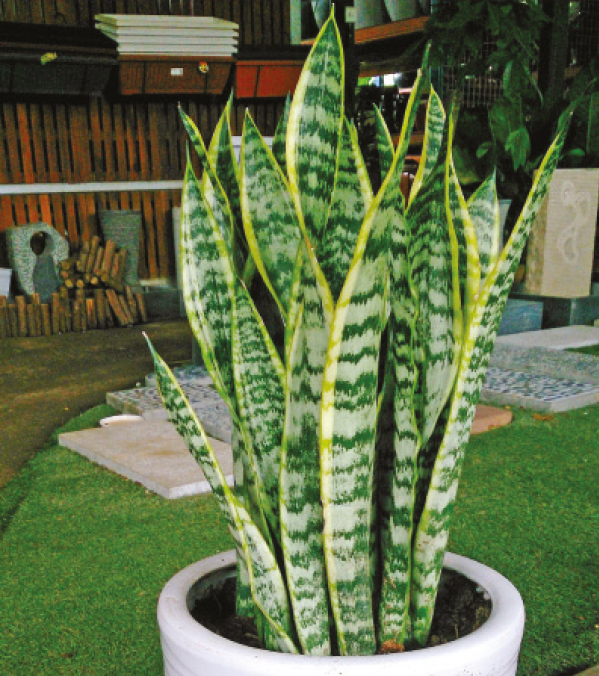
Snake plant photo courtesy of Wikimedia Commons
By Geneva Pattison
Maintaining the air quality in your home may seem like an easy task. However, living in built-up city areas, using central heating and the ever-present dust means we don’t always realise it could be better and sometimes we need a little assistance in the matter.
NASA – The National Aeronautics and Space Administration, released a study available to read online regarding the relationship between certain houseplants and air quality. The ultimate goal of the investigation was to measure the effectiveness of these plants for filtration purposes, in the hopes they would improve the quality of life for future off-planet living.
The study was undertaken in 1989 and covers which plants are best to filter out certain residual toxins from the home to avoid the phenomenon they call “sick building syndrome”, which can cause people unpleasant symptoms.
This phenomenon was studied by Dr. Tony Pickering of Manchester who found that symptoms were minimised “in naturally ventilated buildings that contained the highest levels of micro-organisms.”
In this exploration of nine varieties of plants, NASA studied the roots, leaves and soil microorganisms to examine the potential for each of these factors to aid in the filtration of certain pollutants. Here’s a round-up of some the best and most easy to care for plant specimens from the list.
Variegated Snake Plant
With its dramatically spiky leaves and easy-going nature the snake plant makes for a welcome addition to any home. Also known as “mother in law’s tongue”, this low-maintenance perennial can thrive in any condition and light. It can survive for up to six weeks without water when out of direct light. However, you should check this plant’s soil moisture every two weeks.
This architectural specimen can remove formaldehyde, benzene and carbon monoxide from your living space. We’re usually advised to keep plants out of the bedroom, as they secrete carbon monoxide at night, but the snake plant is the total opposite, it releases oxygen at night so it’s perfect for the bedroom.
A word of warning: it is toxic to cats and dogs, so best keep pets away if you have any.
Peace lily
Peace lilies are perfect for shaded areas, so if your home doesn’t get much light this is the plant for you. Rated high on NASA’s evaluation chart, this plant filters out ammonia, formaldehyde, benzene and many other common air pollutants. They’re relatively easy to grow although, watch for warning signs like yellowing leaves, wilting or failing to produce flowers. Any of these signs can indicate something is wrong and you may need to re-evaluate positioning.
As with all flowering plant species, the peace lily releases some pollen when in full bloom, so take this into account if allergies will be a problem. Again, best keep pets at a distance from this plant.
Aloe Vera
Great for soothing sunburn and long associated with its healing properties, the aloe vera plant can also be a natural alarm to certain toxins overtaking your home. If they develop brown marks on their leaves without relevant cause such as overwatering or leaf burn, it may be a sign that toxins have built up in your house. It does also feature in the report as a lower level filter of toxins but not by a huge amount.
This plant will thrive in certain conditions and bright indirect light is recommended. Remember to water thoroughly but let the soil completely dry between each watering.
Benjamin Fig
The air-purifying properties of the Benjamin fig plant, when tested by NASA in a controlled environment, were also very promising. It was shown to remove 47.4% of formaldehyde and 30% of benzene from the air of the experiment chamber. This particular tree has become quite popular recently for introducing some intrigue to indoor spaces. Its multiple sprouting branches can be trained into a visually-striking twisted design, like growing your own indoor sculpture.
Dracena “Janet Craig”
The Dracena plant of the genus “Janet Craig” was also assessed in the experiment and proved to be very effective at removing trichloroethylene from the air. It showed that 18,330 micrograms of the toxin were eliminated from the testing chamber over a 24-hour period. As for the benzene content in the air of the chamber, that reduced by 77.6%. Dracenas would be a great plant for someone who’s always on the go. They require little water and light but pack a punch visually. Their leaves are dark green and coming to striking points, so they’re ideal if you want to introduce a tropical element to your home.
Where to Start
Living in a major city means pollutants encountered outside can’t always be avoided. However, by improving the air quality in our homes we can put a bit of the control back in our hands and do it in style.
If you are new to the world of indoor plants, www.guide-to-houseplants.com has great information on everything to consider regarding maintenance, including an encyclopedia of plants.
Energia have also published information about the correlation between houseplants and air quality for better living. To find out more visit their blog at https://www.energia.ie/blog/blog/2016/july/july-2016/10-plants-that-help-purify-the-air-in-your-home
Find the full Nasa report at https://ntrs.nasa.gov/archive/nasa/casi.ntrs.nasa.gov/19930073077.pdf



